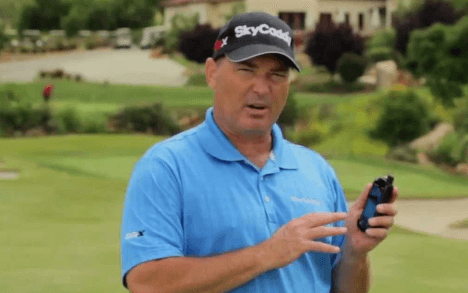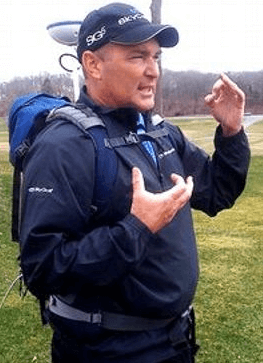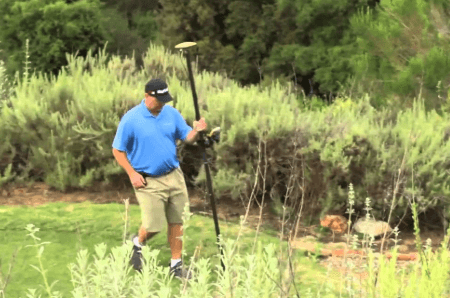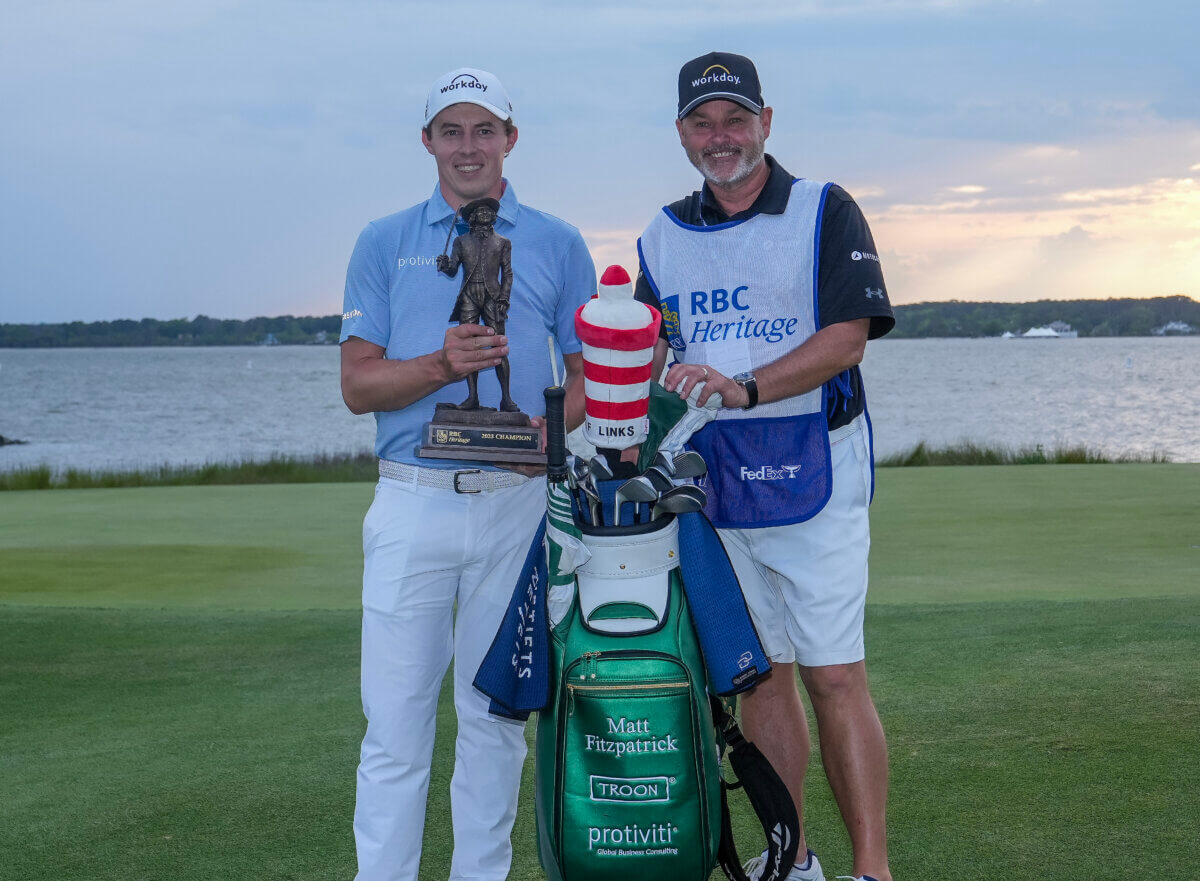Meet Mark Long — the former caddie responsible for creating the incredibly detailed yardage and greens books used on the PGA Tour each week

Mark Long is the mind behind the numbers on the PGA Tour.
About 15 years ago he went from giving yardages to his player as a caddie for Nolan Henke and Fred Funk to becoming the man responsible for making certain the entire field knows exactly where they stand on every fairway and green during the course of a season.
An excellent golfer, meticulous by nature and briefly an aerospace engineering major in college, Long understood the precision Tour caddies demanded. That combination made him the ideal person to take over the Tour’s yardage book trade when pioneer and legend George Lucas retired in the early 2000s.
READ: Caddie legend Chico Fernandez had a 44-year career on the PGA Tour after minor-league baseball stint
Since the mid-2000s, Long’s books have become the gospel on the PGA Tour, selling typically for $40 per week. Sometimes the tournament buys the books in bulk from Long for less than half the retail price and gives them to the players as a gift.
Long also handles yardage books for all USGA national championships as well as the oft-discussed greens books, which sell for $165 per week on Tour.
Late on Sunday afternoon with the tournament title within grasp, a caddie must know the numbers are 100 percent accurate. If he tells his pro it’s 168 yards to carry the bunker protecting the pin, it better not be 169 or 167. Long’s surveying equipment measures within a half-inch.

“It was extremely valuable that everybody did know me and I was out there all the time,” Long said. “We are just ridiculously anal about accuracy and current updates. I’m a maniac about getting it right, really really precise.”
Long grew up about 15 minutes from Woodmont Country Club in Rockville, Maryland. Woodmont has served as a site for U.S. Open sectional qualifying for more than two decades. Tour pros came to play Woodmont’s North and South courses each year with a chance in the national championship at stake. The yardage books available were below the standard they’d become accustomed to on the Tour, so in 1990, Long’s second year as a Tour caddie, he made one for both courses.
That wasn’t his first foray into the bookmaking business. He’d actually made one in Lucas’ style, just for fun at the University of Maryland Golf Course, where he worked the range as a teenager and later honed his game as a member of the Terrapins golf team, playing for Funk.
READ: A caddie legend whose player once nearly got into an on-course fistfight on his behalf
He took another step on his current career path in 1999. Poppy Hills GC was one of three courses in the rotation for the AT&T National Pro-Am and the yardage books were subpar, at best. Peter Jacobsen’s company was running a new PGA Tour event, the Reno-Tahoe Open (now the Barracuda Championship). He asked Long to make the yardage books for the tournament, scheduled for later that year. Long and Jacobsen’s caddie at the time, Chris O’Connell – now one of the nation’s top golf instructors, counting Matt Kuchar among his students – went to Montreux Golf & Country Club and made the books, using rangefinders and reflectors. Later that year, Long also made a yardage book for Spyglass Hill to be used during the Callaway Invitational, a late-season event for touring professionals.
Long was still caddying full time, hopping on Funk’s bag in 2002 for a sensational seven-year run that included the 2005 Players Championship. He made yardage books for 5-10 events a year and figured, at minimum, he’d have a part-time income after he retired from caddying. He had neither the time nor the interest to expand his business. Besides, life was good, traveling the globe aboard a private jet working for a top player who treated him well.
“One of the reasons I don’t caddie anymore is I got real spoiled by Fred’s treatment and performance. Fred is an interesting guy the way he operates. Fred adopts you as a member of the family if you’re around him or working for him,” Long said. “Come live at the house, we’re going to a baseball game. It’s just amazing how incredibly well he treats people, he’s just like you’d think he is. I don’t want to say we’re almost like brothers, but it feels that way because I’ve known him since I was 14.”
Still, Long became equipped for the future. He bought a $19,000 piece of surveying equipment. Google Earth or Google Maps didn’t exist, so every page in the book was hand drawn. Long added a grid, which broke down the green into five-yard blocks, and helped caddies and pros understand the slopes surrounding any hole location.
“As soon as the grid came out, everybody wanted it every week,” Long said.
Out of respect to Lucas, he didn’t pursue opportunities to make yardage books, waiting instead for the offers to come to him.
“Sometimes in business you have to do things better, you have to step up and compete,” he said. “Guys never fully appreciated having George doing what he did for us for so cheap a price.”
MORE: A caddie with a ‘Killer’ nickname | Widespread Panic’s lead singer, tour manager take on roles of player and caddie in PGA Tour pro-am
By the mid-2000s, Lucas had retired. Long attended the annual PGA Merchandise Show in Orlando as a representative of SkyCaddie when several people related to the Tour told him there was a demand for his yardage books each week. Within a year or two, his books had become the new bible.
Taking over the full schedule was a time-consuming transition. Long said he essentially worked every day for seven consecutive years, walking upwards of 30 miles to map a layout. The new job had its perks, such as being able to set his own schedule, but he also was long gone from the course weeks before the traveling PGA Tour circus came to town.
“In doing the yardage books, you don’t have that great social circle anymore,” he said. “You make your own schedule, I just don’t have to do anything if I don’t want to. That’s the part I really enjoy, completely being in control. I want to run the show. I’m one of those caddies … one reason it was so much fun working with Fred, I felt like I had a huge impact, influence or input. When you have that it’s a lot of fun as a caddie. You also feel responsible for everything that goes wrong – because you think you could’ve done something about it.”
Long carries the same approach to making the yardage books. Working closely with computer programmers who are also excellent golfers, they’ve created software that fits his exact needs and eliminates human error. Long doesn’t have employees but has several independent contractors who help him map courses around the area. Alone, he has more than $200,000 in equipment used to make the books.

“The only error that can exist is instrument error,” he said. “Our software looks like it’s flawless on taking the information and calculating the information. We’ve never seen a problem and we check it quite a bit.”
Long also returns to each course each year to ensure nothing has changed. If a fairway line has moved or a green is one inch higher due to topdressing and mowing, his equipment detects the change. He makes a new yardage book rather than updating the one from the previous year, noting each tee plate or marker.
https://www.instagram.com/p/B3U54L0lpqQ/
On a first-time Tour course, such as Eagle Point Golf Club, host for the 2017 Wells Fargo Championship, it took him roughly four hours to chart each hole, using a 7-foot surveying tool with an antenna perched on top to measure yardages from sprinkler heads, hazards, trees and any other point a caddie might find useful once the tournament begins.
Long is contemplating other fresh, revolutionary details he could add to the yardage books each week, hoping to narrow the gap between information and experience.
Books showing every minute detail on the greens, known simply as ‘greens books’ on the PGA Tour, have been, in recent years, scrutinized by the press, regulated by the USGA and dismissed by certain pros. Yet, Long said his billing data proves that almost every player ranked in the top 40 in the world uses a greens book in each tournament and not many in the 100-150 range opt to purchase one.
“With one putt on the weekend you could pay for greens books for two years,” he said.
Also, since the beginning of the 2018-19 season every PGA Tour winner has purchased a greens book with the exception of two tournaments: The Masters, where Long – and nobody else – is allowed to make one due to Augusta National’s regulations and the Corales PuntaCana tournament in the Dominican Republic where he chose not to make one.
“If you don’t buy the current greens book then your book (from the previous year) is wrong,” Long said. “The green shape is different. A 3-foot error changes the way the putt breaks.”
It’s been an interesting ride for Long, who never even planned to be a full-time caddie. During the decade he worked for Henke, they had a running joke. Henke would play two or three events in a row and then before the two parted ways for a week or two break, he’d ask Long if he was going to return.
Long always returned. He returned to sharpen his impeccable impression of Seve Ballesteros (see video below) and trade a few tales with his fellow loopers and of course for the action inside-the-ropes. That’s what always attracts those souls who feel most comfortable with a bag on their shoulder and a bib on their back. These days Long plies his trade with more sophisticated tools, but remains in the game through his data, compiled in a precise manner and later kept safely in back pockets on the game’s biggest stages around the world.







Mark,
You are a class act yourself, enjoyed my time with you when I was able to get out on tour and do Bible Studies with the Caddies.
You still do the best “Seve” imitation ever.
Mark em long and straight Bruh
I think George Lucas is the father of the yardage books we use today.
I think it mentions that in the article.
He do great job.,the best ever. Very good 👍 Mark Long
Mark also juggles a golf ball well. He’s quite impressive!